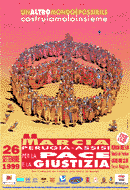
March for peace Perugia Assisi 1999
History of March for peace Perugia Assisi 1999 - Part 1
Back to index
I've been thinking about a march for peace for years and I even announced it, once, in agreement with Emma Thomas, so that “Essor” in Geneva published the news. But the idea didn't come true for several reasons. In spring 1960, when I was taking stock of the activities undertaken and to come with some friends in Perugia, I realised that the idea of a march, especially a popular and a regional one, was welcome. But only in summer did it take shape precisely in special meetings that led to the foundation of a grass-root committee. My intention was for the grass-root group not to consist largely of party members. I'm a supporter of other types of work in addition to that of parties, which I think are useful in a democratic society, but not sufficient. And I've always been “independent” (though a disciplined independent) precisely to promote additional activities.
[...] The first announcement circular for the March dates back to summer 1960. (...) I immediately got support from the schoolmaster Gianandrea Gavazzeni. For months, we sent circulars and private letters and I got a very encouraging letter from MP Pietro Nenni, in November 1960. However, I must admit that, apart from the first characteristic- for the initiative not to be party-led - which would help me gain support from all the people and organisations engaged for peace in Italy, I was concerned with another characteristic. This was in fact the initial motive of the entire project: the march should be popular and mostly regional. In the countryside, on Sundays in the postwar periods of my life, I had seen swarms of women wearing mourning because of the wars, and I knew of many youngsters, ignorant and unaware, who'd been sent to kill and die by an immediate command from above, and I wanted to do something in order for this not to happen ever again, at least to the people of my land. How could I spread the news that peace was in danger, how could I awake the most isolated people, if not by asking other people for help and inaugurate a regular and elementary event, such as a march? (...)
Convinced, as I was, that I had to reach the most isolated populations of the region, I had to ask other people to help me spread the announcement and transport the people who came from distant places. I knew that both helpers (even if they agreed on certain conditions) and participants would be largely unconvinced with regard to non-violent ideas. I knew that perfectly well, but this is in fact the third characteristic of the event that I want to highlight: that was an occasion to talk about “non-violence” to “violent” people, to show them that non-violence is active and progressive, that it's critical of the existing evil and that it tends to attract much solidarity as well as decisive refusals to co-operate; it's also clear and rational in tracing the general lines of what you're supposed to do when faced with a difficult moment.
For centuries, perhaps, nobody in Italy had talked about peace so overtly, in such a popular way. In the meantime, the supreme lessons of Jesus, of the first Christians, of Saint Francis had been covered, mitigated and submitted to other lessons, those of self-defence, the greatness of your fatherland, submission to authority and even colonial war, that were preached from other altars (...). Here comes the fourth characteristic of the event: the choice of Assisi as the destination of the March, which could not but start from Perugia, for organisational reasons. If the March was to be regional and popular – partly because Umbria is a region without war bases or factories – there was no better destination than Assisi, which is within reasonable distance from Perugia, in an extremely popular area, in a landscape of exceptional beauty (the same that Saint Francis saw) and whose access is independent of Saint Francis' church. Assisi is very dear to the Umbrian people, even to those who are not Catholic believers, for its centrality, its rare beauty, its enthusiastic, loving, serene and popular character, that of the Saint, for the celebration of the “familiarity” that the people of this region pride themselves on. This is why I found it a good thing for the destination to be in Assisi. We wanted to repeat something that we, the members of the Centre for non-violence had done many times, but this time, we wanted to induce as many people as possible to join.
We encountered criticism and refusals because the destination was Assisi, as if we were making concessions to the Catholic power or accepting compromises with the traditional religion. Making a connection between Saint Francis and Gandhi (a common parallel in the East) meant to sever the non-violent orientation of these two figures from individual circumstances and attitudes. Besides, it was a stimulus to penetrate in the traditional Italian religion, as it is felt by people and especially by women: the idea that sanctity can well exist without the blessing of a confessional authority. The March was supposed to serve this “opening” purpose, too (this is why our Centre distributed three thousand copies of a monograph about Gandhi on the day of the March). When, in the humbler population layers and, more importantly, in Italy, we arrive at putting the portrait of Gandhi in church, next to the saints, we'll really have the religious reformation that Italy has been awaiting since the Twelfth century, since the times of Gioacchino da Fiore.
(These texts were translated from Italian by Sabrina Fusari)